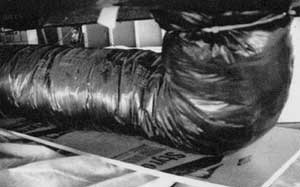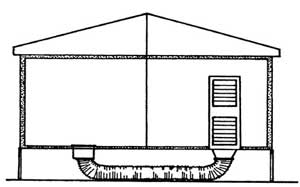News & Notes Archive - December 2007
“I smell a rat” – or, How I learned first hand about the heating and cooling system of my manufactured home. A cautionary tale.
For the past seven years Susan and I have lived in our three-bedroom, two-bath double wide manufactured home, and we really love it. We bought it new, and it was a big reason why I was inspired to research and write my two consumer guides. While I researched these remarkable homes extensively (and continue to do so), from time to time our home itself has taught us a thing or two. I want to share here one of the lessons learned, so you’ll know the right questions to ask about the home model you may consider purchasing.
Recently, just before Halloween, we began to detect the smell of something dead permeating the house. Sniffing around (literally), we determined the source was the floor vents. It was really gross, especially when we slept at night, or tried to sleep.
“You think a mouse or rat somehow got into the duct system and died?” Susan asked.
I did, and changed into my muck-about clothes, and explored the crawl space beneath the house, flashlight in hand. Our home is pit set on a monolithic slab of concrete and has cinderblock skirting all around. The clearance beneath the cross-braces is 19 inches. To move around under there, I bought a creeper from an auto parts store, the kind mechanics use under cars. Works great, but it would certainly be better if the clearance were two feet or more.
Rodent/insect-proofing the crawl space
Now, one thing we did when our home was being installed was, after the masons had finished putting in block skirting all around, I bought an armload of six foot long foam pipe insulation tubes, the kind you put around water pipes to keep them from freezing, and wedged them into the one-inch space between the top of the skirting blocks and the outer rim of the house’s perimeter frame, all the way around. I then carefully plugged any spaces remaining with squirts of fast-drying foam insulation (available at hardware stores). Doing so effectively sealed off the entire crawl space beneath the house from any possible intrusion by rodents and/or insects (especially wasps looking for a nest location).
Two mistakes I made
Well, that worked fine until this fall. Looking back, this past summer, when I was under the house stringing some TV cable, I had noticed some mouse droppings. Being a bit impatient, instead of taking time to look for the opening the critter had made, and plugging it, I bought a few boxes of D-Con poison and set them out.
That was my first mistake. Clearly what happened was a rat or a mouse ate the poison, then retreated to the cozy nest they had made somewhere in the home’s ducts, and died. A recipe for disaster.
What I should have done was use old reliable Victor mouse traps (and rat traps) so I could safely remove the bodies before they began to decay. And searched for, found, and plugged the entry holes.
My second mistake was not visually inspecting the home’s ducting system to spot (and seal) holes and entry points made by rats and mice. As it turned out, when I got around to doing this, I discovered a very dead and smelly rat next to a torn opening of what is called the coiled crossover duct.
This consists of round bulky flexible ducting, 18-20 inches in diameter, wrapped in insulation and black plastic, at the center of which is a 12-inch diameter tube that connects the home’s furnace to the duct system on the home’s second section. See diagram and photo.

Crossover air duct connecting home’s heating/cooling output to duct system in the home’s other section.

Diagram of crossover duct connecting furnace output to adjacent home section
Flexible crossover ducts vs. in-floor cross-over ducting
The above diagram and photo show examples of a flexible crossover duct, such as we have in our home. But there is a second type of crossover. This is a rigid duct assembly in the floors of the two home sections that comes together as the two sections are married together, and which connects to the heating/cooling system.
In my view this set-up is superior to the flexible crossover ducting because it is not vulnerable to rodent infestation. When your looking at homes, ask your sales associate which crossover duct system the model has. Both are fine, but I would prefer the in-floor system.
Moreover, many flexible crossover ducts lay on the concrete slab, which technically is not allowed. They should be raised, suspended, at least four inches off the ground or slab, using plumber’s tape or some other support. Notice in the above photo that sheets of rigid insulation foam have been placed beneath the ducting to prevent head loss. This is a prudent strategy, especially in areas where extremes of heat or cold occur in the crawl space.
Rodent proofing your ducts
We never did figure out if the smell in the house came from the dead rat I discovered, or from dead critters inside the ducts or between the walls. But ten days later the smell was gone. While we waited for the odor to dissipate, I inspected the entire perimeter of the block skirting, found a small opening that had been chewed through the pipe insulation, and patched it with foam insulation. I also bought Victor mouse traps and set them. After catching one mouse, the traps have since been untouched. But just in case, we keep them baited, and check them every ten days. So far, so good. We continue to do this.
But that’s not all. When I inspected–for the first time really–the entire length of the flexible crossover ducting and discovered two places where the home installer had left exposed about a foot of outer insulation, failing to pull the outer plastic covering together and carefully taping it with duct tape. This oversight was an invitation for rats and mice to burrow into the insulation and make a nest, or use the insulation to build a nest. I carefully taped these closed.
In several other places I found where portions of the outer insulation had pulled away where it connected to the home’s plastic weave belly insulation wrap, exposing openings through which mice could easily access the home’s interior wall spaces. These I carefully sealed with industrial grade duct tape.
Conclusion, and a tip
The lesson we learned was, from the very outset of ownership, homeowners need to be pro-active and make sure after installation that things are in order underneath the home, as well as inside. If necessary, hire someone to inspect your home’s crawl space to ascertain that things are okay. If we had done this, the obvious failures would have been discovered and quickly remedied. And chances are we never would have smelled a rat!
Interview: 15 minutes with...Melvin Hendrickson
Note: In my role as an industry observer and consumer advocate I speak with people at all levels of the manufactured home industry (MH) to gain insights I share with my readers to help them be better informed. Some I have interviewed for a one-page column that runs in an industry trade publication. In return the magazine runs an ad for the Grissim Guides. No money changes hands. I insist on this. Aside from book sales, I neither solicit nor accept a dime from the industry, and my readers have my assurance I intend to keep it that way. Here’s this month’s interview:

Melvin Hendrickson, founder and co-owner of Hendrickson Mobile Estates of Sequim, Washington
Who: Founder and principal, MC Construction, Inc., and partner (with his two sisters), in LJM Properties, owner of Hendrickson Mobile Estates, both of Sequim, WA.
Background: Age, 50. Born and raised in Sequim, WA (on the Olympic Peninsula, west of Seattle). “My dad was a commercial general contractor, and as a kid I spent a lot of time at job sites, working for him during the summers.” Graduated from Sequim High School in ’76, receiving that year his pilot’s license (“I picked flying up from dad. He had work around the state so he flew a lot.”) Following a year at Peninsula Community College, went to work full-time for his father. When a back injury from a ’79 motorcycle accident prevented him from further construction work, he transitioned to the company’s office, becoming a project manager/estimator. (“Over the years I’ve taken a lot of continuing education courses in Seattle sponsored by the Association of General Contractors.”) In ’83 he married Cherie Haller, a native of nearby Port Angeles.
In 1990, with the local commercial construction industry in a slump and steep interest rates stalling new home construction, father and son, with no previous MH experience, started Hendrickson Mobile Estates, a 55+ MH land-lease community (no single-wides) on a portion of 32 acres the family owns inside Sequim city limits. Growing incrementally (“We started with fifty units and grew it from there”), the LLC currently has 91 homes on 17 acres, and has just begun the second phase, completing the infrastructure on the remaining 15 acres with lots for an additional 66 homes (including 12 lots configured for triple-wides). Hendrickson’s company, MC Construction Inc., in addition to selling and installing MH homes into the LLC, takes on outside commercial projects, currently including the $2-1/5 million Rock Plaza mall on the city’s north side. An outdoorsman and hunter in his spare time, he is an active member of the Peninsula Flying Club. The Hendricksons have two daughters, Taria, 20, in her second year of college, and Lauren,16, a student at Sequim High School.
- Q: About a year ago the New York Times ran a feature about retirees and others flocking to Sequim, population 5,000, and how it has become one of the country’s top retirement destinations. Did you see this coming in 1990?
- A: Absolutely no way! (laughs) We were very lucky and blessed. This land had been in the family since the early seventies. I grew up riding horses and motorcycles on it. It even had a landing strip. Until the late eighties, Sequim was literally a one stoplight town. In 1990, with the construction industry around here crashing, we were working our tails off and not going anywhere. I said, ‘Dad, why don’t we look into a mobile home park’. So we did, and we went for it.”
- Q: How was it in the early going?
- A: Slow at first. We had to improve the road and put in sewer and water, then give it all back to the city. Initially, we let other dealers and installers put in homes because we wanted growth. But there always seemed to be conflicts: who did what with other homes. So I decided, I’m going to provide a turn-key purchase, one-price for the whole project. I’d take care of everything. Within a few years, business took off. We were doing about 20 homes a year, all I could handle.
- Q: What brand were you selling?
- A: We started with Fleetwood–their higher end Barrington series. Then we switched to Palm Harbor, but when their company-owned dealerships got busy, our orders often got bumped, causing delivery delays. So we switched again, this time to Homebuilders Northwest out of Oregon. They’re small but very reliable and build an excellent home. They have a great long-time experienced crew with profit sharing. Makes a big difference.
- Q: What’s a ballpark figure for a home purchase, say, a doublewide?
- A: The average home runs around $130,000, including an attached garage, site prep, installation, hookups, permits, everything. All our homes are pit set on monolithic slabs, with jack stands and anchor strap tie-downs. Plus perimeter blocking, which is required by Washington law.
- Q: And the rents?
- A: In the older section we’re at $325 a month. We pay water, sewer and garbage. In the newer section where everyone is individually metered, rent starts at $275 for a double-wide with a single-car garage–ten dollars more for a two-car garage–up to $300 for a triple-wide with a two-car garage. Interestingly, when we first started, residents were in the 75-80 age range and everyone wanted small homes and rock gardens. Lately, the new arrivals are mostly in their sixties and are very active. They want lawns and gardens. As for the pace of our rent increases, I’d say we’ve averaged around seven dollars a month per year annual increase. The increases are pretty much cost-of-living pass-throughs–utility increases and such. We’re still equal to, or lower, than all the other land-lease communities in Sequim.
- Q: Is there a homeowners association?
- A: Nope. We don’t have any club house or recreation area.
- Q: What’s been your foreclosure picture over the years?
- A: We’ve never had one. Seriously. We had one elderly tenant who got into a pinch, but we opted to carry the rent and collect it after she passed on and her house was sold. It’s nice working with 55 and above for the whole park. They’re stable, always beating the door down to pay you. That generation. I’d say 90% of the residents paid cash for their home.
- Q: What’s the outlook for filling in your just-completed Phase 2?
- A: Encouraging. This past summer, while we put in the streets and infrastructure on those 15 acres–which ran around $600,000–we had 19 homes waiting here in storage. I gave people the option of locking in price to avoid price increases. We didn’t charge any storage fee. They saved on average around $5,000. For example, all the city permit fees recently went up, from $9,700 to just around $14,000. Right now, business has slowed a bit. I’ve got four customers who would buy right now if they could sell their home, so we’re seeing some effect from the slump in the housing markets.
- Q: What’s been the most rewarding aspect for you?
- A: Being able to feed my family. And I enjoy driving through here and looking at all we’ve accomplished. We’ve worked hard. I have employees who’ve been with me a long time. I’ve watched them mature, make the same mistakes I made. I enjoy helping those guys out, and being able to live comfortably.